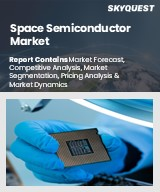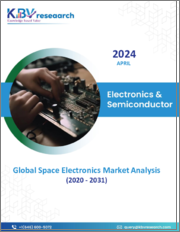
|
시장보고서
상품코드
1796436
우주용 반도체 시장 규모, 점유율, 성장 분석 : 컴포넌트별, 용도별, 플랫폼별, 지역별 - 산업 예측(2025-2032년)Space Semiconductor Market Size, Share, and Growth Analysis, By Component (Integrated Circuits, Discrete Semiconductors), By Application (Satellite Communications, Space Exploration), By Platform, By Region - Industry Forecast 2025-2032 |
||||||
세계의 우주용 반도체 시장 규모는 2023년에 26억 3,000만 달러에 달하며, 2024년에는 28억 3,000만 달러, 2032년에는 49억 3,000만 달러로 성장하며, 예측 기간(2025-2032년)의 CAGR은 7.2%로 성장할 전망입니다.
세계 우주용 반도체 시장은 우주탐사, 위성통신, 국방기술에 대한 수요 증가로 크게 성장하고 있습니다. 인공위성 별자리, 심우주 임무, 모니터링 시스템에 대한 정부 및 민간 기관의 투자가 강화됨에 따라 방사선, 극한의 온도 등 가혹한 우주 환경에 견딜 수 있는 특수 반도체의 필요성이 급증하고 있습니다. 이러한 시장 확대는 차세대 용도에 필수적인 마이크로 일렉트로닉스, 전력 관리, 고속 데이터 처리의 기술 발전에 힘입어 더욱 가속화되고 있습니다. 인공지능과 엣지 컴퓨팅을 위성에 통합하는 것도 작고 강력한 반도체에 대한 수요를 증가시키고 있습니다. 전반적으로 신뢰성, 에너지 효율, 내구성이 강조되면서 우주용 반도체 부문의 미래를 형성하고 있습니다.
목차
서론
- 조사의 목적
- 조사 범위
- 정의
조사 방법
- 정보 조달
- 1차와 2차 데이터 방법
- 시장 규모 예측
- 시장의 전제조건과 제한
개요
- 세계 시장 전망
- 공급과 수요 동향 분석
- 부문별 기회 분석
시장 역학과 전망
- 시장 개요
- 시장 규모
- 시장 역학
- 촉진요인과 기회
- 억제요인과 과제
- Porter의 산업 분석
주요 시장 인사이트
- 주요 성공 요인
- 경쟁의 정도
- 주요 투자 기회
- 시장 에코시스템
- 시장의 매력 지수(2024년)
- PESTEL 분석
- 거시경제 지표
- 밸류체인 분석
- 가격 분석
- 기술 분석
- 사용 사례
우주용 반도체 시장 규모 : 컴포넌트별 & CAGR(2025-2032년)
- 시장 개요
- 집적회로
- 디스크리트 반도체
- 옵토일렉트로닉스
- 센서
우주용 반도체 시장 규모 : 용도별 & CAGR(2025-2032년)
- 시장 개요
- 위성통신
- 우주 탐사
- 지구 관측
- 내비게이션
우주용 반도체 시장 규모 : 플랫폼별 & CAGR(2025-2032년)
- 시장 개요
- 위성
- 발사체
- 우주 정거장
- 심우주 탐사기
우주용 반도체 시장 규모 & CAGR(2025-2032년)
- 북미
- 미국
- 캐나다
- 유럽
- 독일
- 스페인
- 프랑스
- 영국
- 이탈리아
- 기타 유럽
- 아시아태평양
- 중국
- 인도
- 일본
- 한국
- 기타 아시아태평양
- 라틴아메리카
- 브라질
- 기타 라틴아메리카
- 중동 및 아프리카
- GCC 국가
- 남아프리카공화국
- 기타 중동 및 아프리카
경쟁 정보
- 상위 5사의 비교
- 주요 기업의 시장 포지셔닝(2024년)
- 주요 시장 기업이 채택한 전략
- 최근 시장 동향
- 기업의 시장 점유율 분석(2024년)
- 주요 기업의 기업 개요
- 기업의 상세
- 제품 포트폴리오 분석
- 기업의 부문별 점유율 분석
- 매출의 전년대비 비교(2022-2024년)
주요 기업 개요
- Northrop Grumman Corporation(미국)
- Teledyne Technologies Incorporated(미국)
- Infineon Technologies AG(독일)
- STMicroelectronics N.V.(스위스)
- Texas Instruments Incorporated(미국)
- Cobham Advanced Electronic Solutions(미국)
- Microchip Technology Inc.(미국)
- Renesas Electronics Corporation(일본)
- Honeywell Aerospace(미국)
- Analog Devices, Inc.(미국)
- Astron Semiconductors(미국)
- Nebula Microsystems(영국)
- ALD Advanced Microsystems(프랑스)
- VORAGO Technologies(미국)
결론과 제안
KSA 25.08.29Global Space Semiconductor Market size was valued at USD 2.63 Billion in 2023 poised to grow between USD 2.83 Billion in 2024 to USD 4.93 Billion by 2032, growing at a CAGR of 7.2% in the forecast period (2025-2032).
The global space semiconductor market is experiencing significant growth driven by the increasing demands of space exploration, satellite communications, and defense technologies. As investment from both governments and private organizations intensifies in satellite constellations, deep-space missions, and surveillance systems, the necessity for specialized semiconductors that can withstand harsh space conditions, such as radiation and extreme temperatures, is surging. This market expansion is further fueled by technological advancements in microelectronics, power management, and high-speed data processing, which are essential for next-generation applications. The integration of artificial intelligence and edge computing into satellites also elevates the demand for compact and powerful semiconductors. Overall, there is a strong emphasis on reliability, energy efficiency, and durability, shaping the future of the space semiconductor sector.
Top-down and bottom-up approaches were used to estimate and validate the size of the Global Space Semiconductor market and to estimate the size of various other dependent submarkets. The research methodology used to estimate the market size includes the following details: The key players in the market were identified through secondary research, and their market shares in the respective regions were determined through primary and secondary research. This entire procedure includes the study of the annual and financial reports of the top market players and extensive interviews for key insights from industry leaders such as CEOs, VPs, directors, and marketing executives. All percentage shares split, and breakdowns were determined using secondary sources and verified through Primary sources. All possible parameters that affect the markets covered in this research study have been accounted for, viewed in extensive detail, verified through primary research, and analyzed to get the final quantitative and qualitative data.
Global Space Semiconductor Market Segments Analysis
The global space semiconductor market is segmented based on component, application, platform, and region. In terms of component, the market is divided into integrated circuits, discrete semiconductors, optoelectronics, and sensors. Based on application, the market is segmented into satellite communications, space exploration, Earth observation, and navigation. Based on platform, the market is categorized into satellites, launch vehicles, space stations, and deep space probes. Based on region, the market is segmented into North America, Europe, Asia-Pacific, Central & South America and the Middle East and Africa.
Driver of the Global Space Semiconductor Market
The increasing reliance on satellite technologies for navigation, Earth monitoring, observation, and global communication is driving a significant demand for advanced space-grade semiconductors. These essential components facilitate efficient data processing, enable low-latency transmissions, and provide operational resilience in the harsh conditions found in space. Moreover, the expansion of low Earth orbit satellite constellations across commercial and defense sectors is further fueling the growth of the market. As these technologies become integral to various applications, the need for high-performance semiconductors designed to withstand the rigors of extraterrestrial environments continues to rise, positioning the market for robust development.
Restraints in the Global Space Semiconductor Market
The global space semiconductor market faces significant challenges stemming from the high costs associated with designing and producing space-grade semiconductors. This expense is largely due to the requirement for specialized materials, rigorous testing protocols, and stringent regulations that govern aerospace electronics. Additionally, the lengthy qualification processes further complicate and prolong product development timelines. These financial burdens and extended qualification cycles can deter smaller and mid-sized semiconductor manufacturers, restricting their ability to enter the market and diminishing overall market penetration. As a result, these factors collectively hinder the growth and competitiveness of the global space semiconductor sector.
Market Trends of the Global Space Semiconductor Market
The global space semiconductor market is witnessing a significant trend toward the integration of Artificial Intelligence (AI) in the design and testing processes of space components. This shift facilitates accelerated simulation speeds tailored for space environments, improves fault detection and tolerance mechanisms, and streamlines the qualification of components for both aerospace applications and on-orbit deployment. Such advancements not only minimize time to market but also enhance the overall performance of space technologies. Consequently, stakeholders are increasingly investing in AI-driven solutions, recognizing their potential to revolutionize the efficiency and reliability of semiconductor components critical to space missions.
Table of Contents
Introduction
- Objectives of the Study
- Scope of the Report
- Definitions
Research Methodology
- Information Procurement
- Secondary & Primary Data Methods
- Market Size Estimation
- Market Assumptions & Limitations
Executive Summary
- Global Market Outlook
- Supply & Demand Trend Analysis
- Segmental Opportunity Analysis
Market Dynamics & Outlook
- Market Overview
- Market Size
- Market Dynamics
- Drivers & Opportunities
- Restraints & Challenges
- Porters Analysis
- Competitive rivalry
- Threat of substitute
- Bargaining power of buyers
- Threat of new entrants
- Bargaining power of suppliers
Key Market Insights
- Key Success Factors
- Degree of Competition
- Top Investment Pockets
- Market Ecosystem
- Market Attractiveness Index, 2024
- PESTEL Analysis
- Macro-Economic Indicators
- Value Chain Analysis
- Pricing Analysis
- Technology Analysis
- Case Studies
Global Space Semiconductor Market Size by Component & CAGR (2025-2032)
- Market Overview
- Integrated Circuits
- Discrete Semiconductors
- Optoelectronics
- Sensors
Global Space Semiconductor Market Size by Application & CAGR (2025-2032)
- Market Overview
- Satellite Communications
- Space Exploration
- Earth Observation
- Navigation
Global Space Semiconductor Market Size by Platform & CAGR (2025-2032)
- Market Overview
- Satellites
- Launch Vehicles
- Space Stations
- Deep Space Probes
Global Space Semiconductor Market Size & CAGR (2025-2032)
- North America (Component, Application, Platform)
- US
- Canada
- Europe (Component, Application, Platform)
- Germany
- Spain
- France
- UK
- Italy
- Rest of Europe
- Asia Pacific (Component, Application, Platform)
- China
- India
- Japan
- South Korea
- Rest of Asia-Pacific
- Latin America (Component, Application, Platform)
- Brazil
- Rest of Latin America
- Middle East & Africa (Component, Application, Platform)
- GCC Countries
- South Africa
- Rest of Middle East & Africa
Competitive Intelligence
- Top 5 Player Comparison
- Market Positioning of Key Players, 2024
- Strategies Adopted by Key Market Players
- Recent Developments in the Market
- Company Market Share Analysis, 2024
- Company Profiles of All Key Players
- Company Details
- Product Portfolio Analysis
- Company's Segmental Share Analysis
- Revenue Y-O-Y Comparison (2022-2024)
Key Company Profiles
- Northrop Grumman Corporation (USA)
- Company Overview
- Business Segment Overview
- Financial Updates
- Key Developments
- Teledyne Technologies Incorporated (USA)
- Company Overview
- Business Segment Overview
- Financial Updates
- Key Developments
- Infineon Technologies AG (Germany)
- Company Overview
- Business Segment Overview
- Financial Updates
- Key Developments
- STMicroelectronics N.V. (Switzerland)
- Company Overview
- Business Segment Overview
- Financial Updates
- Key Developments
- Texas Instruments Incorporated (USA)
- Company Overview
- Business Segment Overview
- Financial Updates
- Key Developments
- Cobham Advanced Electronic Solutions (USA)
- Company Overview
- Business Segment Overview
- Financial Updates
- Key Developments
- Microchip Technology Inc. (USA)
- Company Overview
- Business Segment Overview
- Financial Updates
- Key Developments
- Renesas Electronics Corporation (Japan)
- Company Overview
- Business Segment Overview
- Financial Updates
- Key Developments
- Honeywell Aerospace (USA)
- Company Overview
- Business Segment Overview
- Financial Updates
- Key Developments
- Analog Devices, Inc. (USA)
- Company Overview
- Business Segment Overview
- Financial Updates
- Key Developments
- Astron Semiconductors (USA)
- Company Overview
- Business Segment Overview
- Financial Updates
- Key Developments
- Nebula Microsystems (United Kingdom)
- Company Overview
- Business Segment Overview
- Financial Updates
- Key Developments
- ALD Advanced Microsystems (France)
- Company Overview
- Business Segment Overview
- Financial Updates
- Key Developments
- VORAGO Technologies (USA)
- Company Overview
- Business Segment Overview
- Financial Updates
- Key Developments















